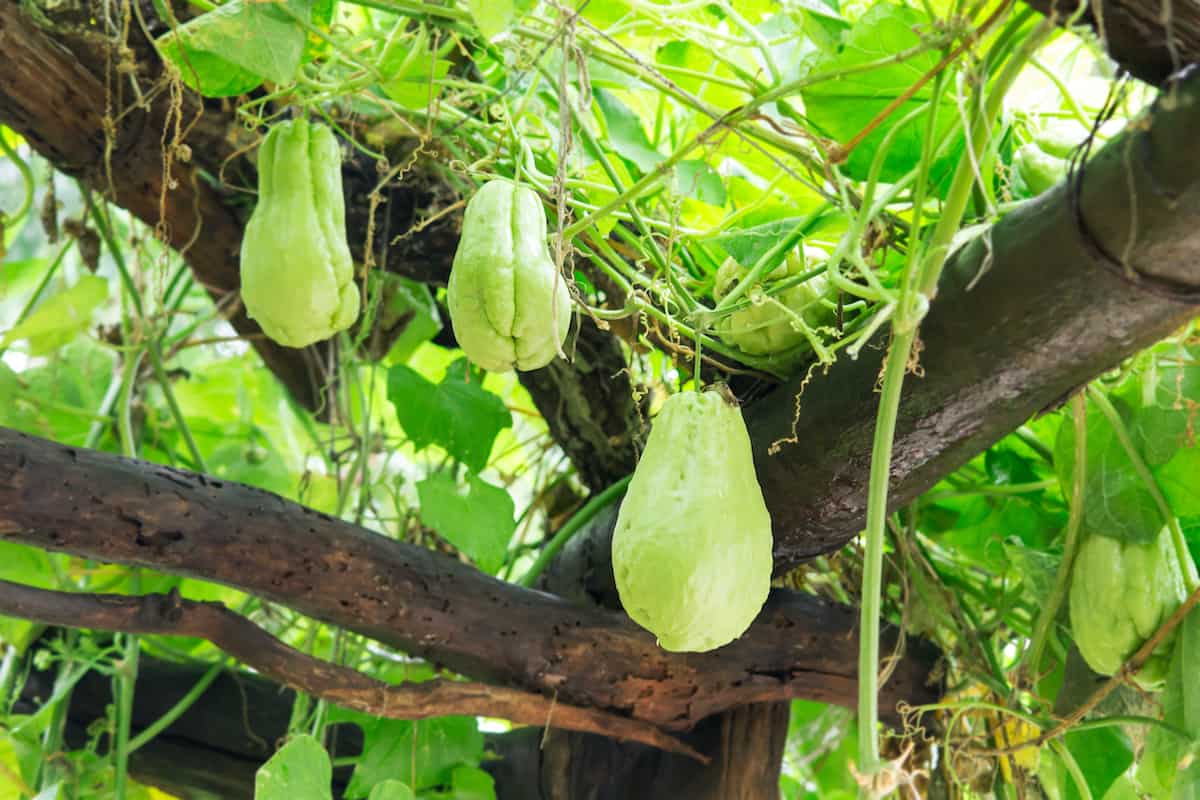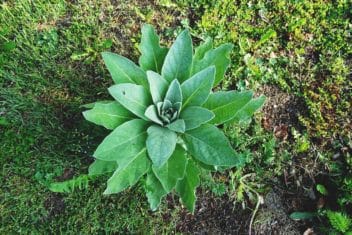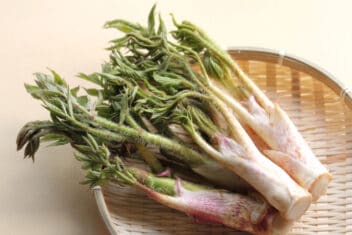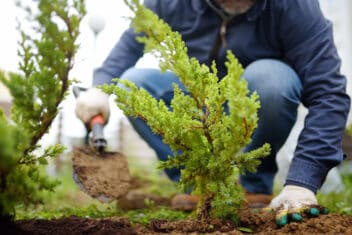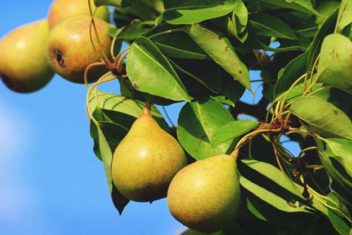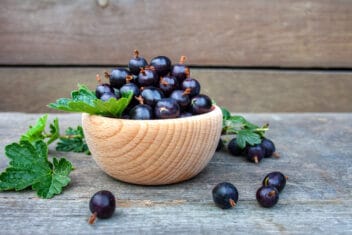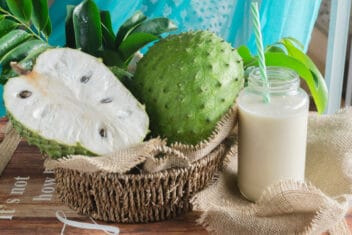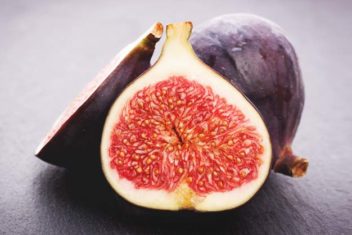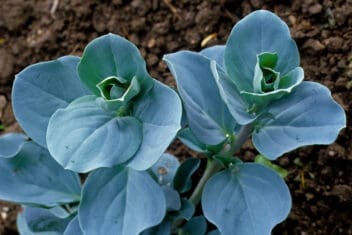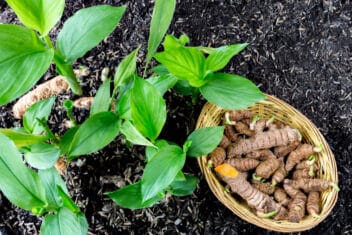Ever run into chayote at the grocery store and wondered what the heck it was? Botanically it’s a fruit, but it’s treated and prepared like a vegetable. It has a wonderfully mild flavor and is intensely prolific. Next time you see one at the store, grab it, and try growing chayotes in your home garden.
Whether you’re a novice or an experienced gardener, chayote is the plant that keeps on giving because you can also eat the leaves, shoots, roots, and seeds!
Ready to learn about this exciting plant, also known as choco, mirliton, vegetable pear, and sayote? Trust me, once you grow chayote, you’ll wonder why you didn’t do it sooner.
Varieties of Chayote
Chayote is well-loved by some people and a complete unknown to others. Related to pumpkins, cucumbers, and squash, this cucurbit is a must-have for any adventurous gardener.
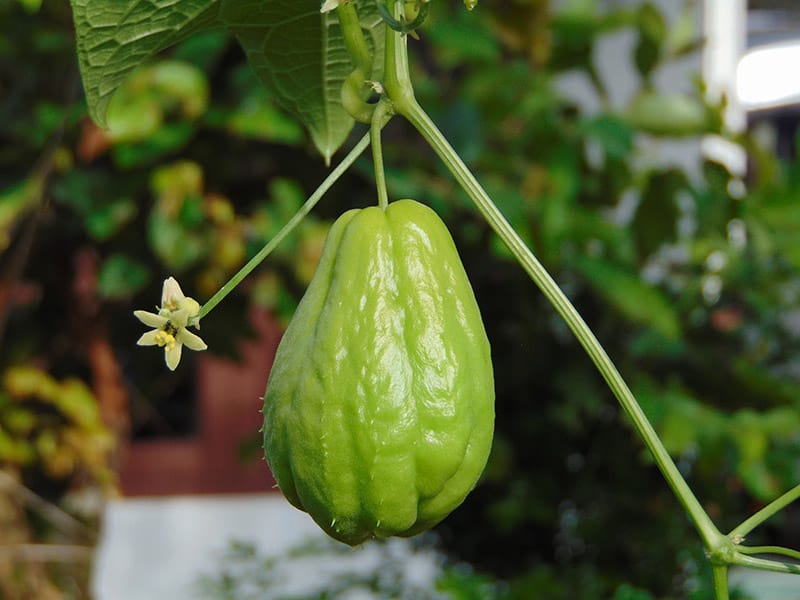
There are two types of chayote. Common chayote is the type you find in the supermarket and in people’s gardens. Wild chayotes grow by streams and rivers. You often find them in ravines. Most wild varieties are more vigorous and the fruit is larger. Wild fruits sometimes have small thorns.
If you purchase a chayote fruit from the store, it’s likely to be a common variety and can be either smooth-skinned or prickly.
Chayote de Caballo
Closely related to the common chayote, the skin is usually prickly, but can be smooth as well. This variety stores for a long time.
Chayotillo
This is a rare variety that has some disease resistance. It looks similar to the common variety and can be smooth or prickly.
Cabeza de Chango
More common to Mexico, this variety survives high humidity.
Perulero
Perulero is light yellow to white in color. Originally grown in Guatemala, it is now grown across North America, as well.
How to Grow Chayote
Chayote is a prolific fruiter and tenacious vine. Because of the amount of fruit you get off of one plant, it’s a good option for a survival garden. One chayote vine is sufficient for a family of four.
Chayote is such an easy plant to grow, and you don’t need to find it at your local nursery. You just need to purchase one single fruit from the store and you can have an ongoing bounty.
Environmental Requirements
Chayote grows well in USDA Zones 7 to 10. It needs between 120 to 150 frost-free days to produce fruit, so you can grow it as an annual even in cooler regions so long as you can give it that much growing time. You can start plants indoors or use protective covers to extend your growing season.
Plant in full sun. Chayote will grow a good vine in shaded conditions, but the fruit harvest will be reduced dramatically.
Put the plant in well-draining soil that is rich in organic matter. Aim for a pH of 6.0 to 6.8. Chayote won’t stand for pooling water so if you live in a high rainfall area, plant in a mound or hill to allow the water to drain off.
When to Plant
Plant in spring when soil temperatures reach a consistent 65°F. This is normally about 4 weeks after the last frost. Chayotes grow naturally in tropical or sub-tropical environments but will do okay in cooler places as well with some protection during the cool weather.
Container Planting
You can grow chayotes in a container, but the yield won’t be nearly as much as when planted in the ground. Plant in a container when you live in a short summer area where you may need to move the container to follow the sun or to move it indoors.
Choose a container that is a minimum of 24 inches deep and can hold 5 gallons of soil. If you go this route, be sure to keep a close eye on the amount of water in the soil and feed monthly with liquid fertilizer.
Planting the Seed
Chayotes don’t have a seed, as such. There is an ’embryo’ inside the fruit which sprouts and a new plant grows from that. This means you plant the whole fruit to get a new plant.
Buy a few chayotes from the store, farmers market, or nab a few from a friend. Older chayotes with tough skin work best.
Place the fruit on top of the counter and wait for it to sprout, kind of like a potato does if you leave it unattended for a while.
When the sprout is about four inches tall and the last frosts are over, plant the entire fruit in the ground. There is a danger of the fruit rotting if you bury it too deep, so plant it at a 45° angle with the sprout exposed out of the soil.
Water well and make sure you have something sturdy for it to start climbing up. Remember, chayote is an extremely big vine.
Spacing
One chayote is normally enough for a family of four with some left over, but if you find you want to plant more than one, space them out 10 feet apart.
Keep in mind that a chayote plant, over time, can take over an entire area. It has been known to crawl over fences and into the neighbor’s yard, or smother gazebos and garages.
Trellis
Chayotes grow fast and big, so you need to provide something for it to grow up. The vine can be as long as 50 feet so plan for big growth.

Chayotes will grow up other trees, over sheds, along fence lines, and up solid trellis. Try to get the vine to a height where the maturing fruit won’t touch the ground. If it does, the fruit will sprout and grow another vine.
Caring for Chayote
Chayotes need some food, water, and mulch to be happy. Here are the details:
Fertilizer
Make sure you dig in well-rotted manure before planting. Then, use an all-purpose liquid fertilizer every six weeks. Add good quality compost as a side dressing halfway through the growing season.
Water
Don’t let the soil around chayotes dry out. Apply even moisture, but make sure not to leave the base pooled in water.
Pruning
Chayote will grow back each year and it pays to give it a hand by pruning the vine back to protect it from the cold.
In temperate climates, cut the vine back, leaving five shoots about six inches in length.
If you live in an area where frosts occur, cut the shoots back so they barely come out of the ground. Add a bit of mulch as protection. Don’t worry, the chayote will grow back.
Mulch
In cool climates, mulch your chayote plant with a layer of 10 to 12 inches of mulch. Being a perennial, you want to mulch the chayote plant after the harvest and before the freezing temperatures arrive.
Companion Planting for Growing Chayote
While there’s a debate about how well companion planting actually works, studies show that some plants can help deter pests. For instance, corn and broccoli deter cucumber beetles, which feed on chayotes. Here are some smart plants to try growing chayote with:
Don’t plant with:
- Mint
- Celery
- Beans
Common Problems and Solutions for Growing Chayote
Chayotes can be affected by some of the diseases that affect the squash family, but the majority of the time, the plant will grow season after season without any issue.
Of the pests and diseases listed, I’ve had a few of them only once or twice in ten years of growing chayote. It’s a fairly hardy plant.
Aphids
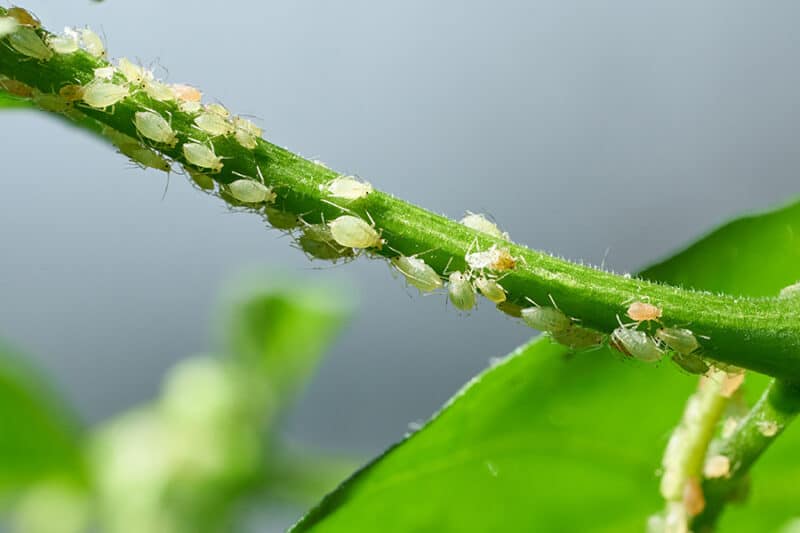
Sap sucking aphids will attack chayote and, because the vine is so big, the numbers can be high. Use a knockdown liquid spray like organic pyrethrum. After that, use neem oil once every five weeks.
Striped Cucumber Beetle
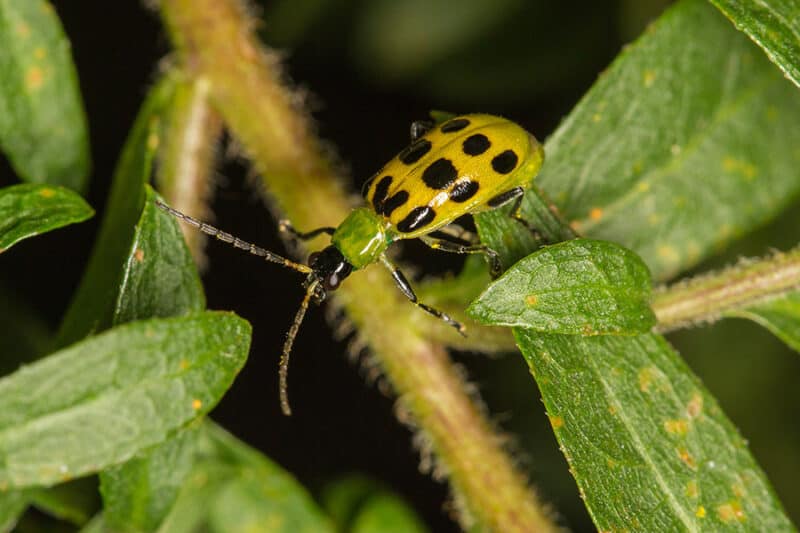
The striped cucumber beetle attacks all plants in the Cucurbitaceae family, including chayotes. Not only does it damage plants by eating them, but it spread disease like bacterial wilt that can take down an entire plant in a matter of days.
The beetles have yellow and black bodies, either with stripes or spots.
You can control them by putting row covers over your chayotes through early summer, though you’ll need to hand pollinate your plants or remove the covers during the blossoming time if you do this.
You should also encourage bats and parasitic flies in your garden, which are natural predators. You should also practice good crop rotation.
Fusarium Crown and Foot Rot
This is from a soil-borne fungus that attacks squash plants, so don’t plant your chayote in an area where you have had other squash varieties for the last two years, especially if they have been diseased in any way.
This fungus will cause wilting of leaves and then the entire plant swiftly dies because the taproot and crown have rotted in the soil.
Remove the entire plant and throw in the garbage. Don’t compost a plant with this disease.
Bacterial Leaf Spot
Small spots will develop into large brown scabs on both the leaves and fruit. Avoid overhead watering, especially in dry, humid environments.
Use a copper fungicide as soon as you notice the growing lesions.
Harvesting Chayote
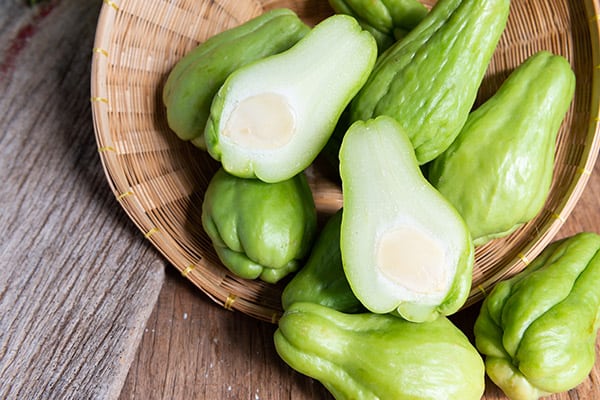
One chayote plant can give you up to 80 fruits, but the bounty doesn’t stop there. You can eat all parts of the plant, from root to tip. Young leaves can be cooked up like asparagus, while the shoots can be used in soups.
You can eat the seeds as you would pumpkin or squash seeds, either roasted or fried. The plant’s tuberous root is delicious boiled or fried like a potato, though they take two years to develop.
Harvest chayotes for eating when the fruit is 4 to 6 inches in diameter. It should have a little give when squeezed gently.
Harvest for pickling when the fruit is about 2 inches in diameter.
Harvest for slicing into salads and eating raw when fruit is about 3 to 4 inches in diameter.
In zones 7 to 10, you’ll see the fruits appear and grow rapidly around October. The vine will keep providing right up to the first frosts.
Using Chayote
Chayotes are full of potassium, fiber, calcium, and vitamin C.
The large chayote fruit in the store that are rock hard are usually bland and tasteless, so if you’ve tried those and hated them, please have a go at growing your own.
The difference in flavor will amaze you. Chayote is popular in South America and when you eat them fresh off the vine, you’ll see why.
Boil and mash them like potatoes. Use salt, pepper, and butter. Stuff them with meat or your favorite filling and roast them in the oven. If you want to make apple pie, but don’t have enough apple, use a little chayote flesh to fill it out.
Chayotes absorb the flavors they’re cooked in, so they go well in rich winter stews and casseroles. Try it cooked with sweet onion and bacon.
Can’t use up all the tasty fruits? Cover them in plastic and stick them in the refrigerator and they can store up to a month.
Note that some people find their skin is irritated by the gelatinous juice that comes out of the skin when you cut into the fruit, so peel them under running water if that’s the case for you.
Storing Chayote
Place your chayote fruit on newspaper and store in a single layer in a cool store, garage or cupboard.
If your winters aren’t too cold, you can leave the fruit on the vine until you eat them. Just make sure to check them regularly for cold damage. Pick them if they start to deteriorate.
Make Chayote a Big Part of Your Garden
Chayote is the most wonderfully interesting plant to grow for food. I don’t know of any other plant where you plant one fruit and end up with up to a hundred each season.
The taste of freshly grown chayote is nothing like the over-size store bought ones. Try growing your own and let us know how you go.
